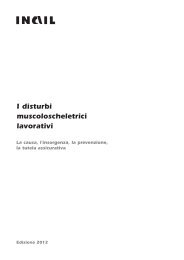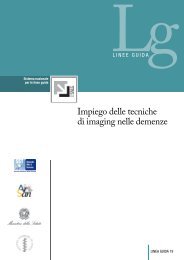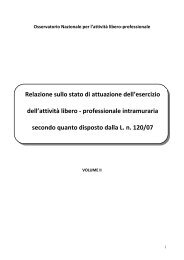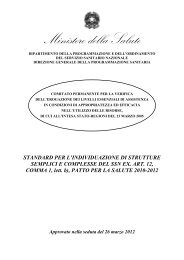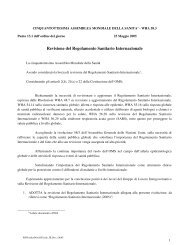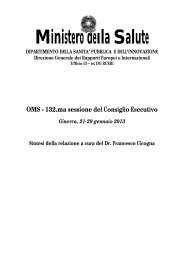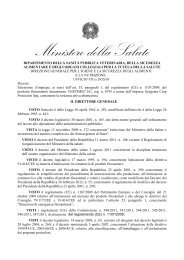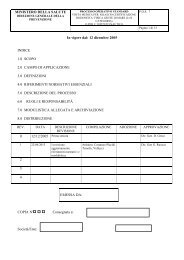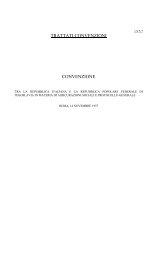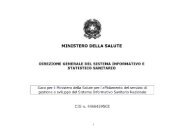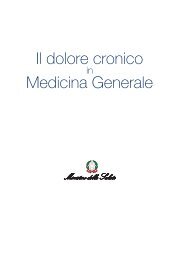hta_ knee intro.qxp - Ministero della Salute
hta_ knee intro.qxp - Ministero della Salute
hta_ knee intro.qxp - Ministero della Salute
Create successful ePaper yourself
Turn your PDF publications into a flip-book with our unique Google optimized e-Paper software.
52<br />
We calculated ICERs only for classes for which cost and effect data were available for two or<br />
more prostheses as follows:<br />
where:<br />
Cbs = Cost of base line prosthesis<br />
n = comparative prosthesis<br />
Cn = Cost of comparative prosthesis<br />
Implant survival rate = 100 – revision rate<br />
8.3 Results<br />
We identified the base line prosthesis (BS) as the prosthesis with the lowest revision rate (i.e.<br />
those for which there is the highest evidence of patient benefit). We did this using survival data<br />
from the 2 registers (Register of the Orthopaedic Prosthetic Implants - RIPO and Australian<br />
Orthopaedic Association National Joint Replacement Register - AOAJRR) by class of prosthesis.<br />
The base line prosthesis was chosen on the basis of its 5 year clinical performance. As each<br />
base line prosthesis can be considered as the best performing within its class, all other prosthesis<br />
should be compared with these. However the highest effectiveness may not necessarily mean the<br />
highest cost-effectiveness as the latter is the ratio of mean weighted cost to performance.<br />
Although it is marginal (or incremental) cost-effectiveness which should be used for decision<br />
making purposes the choice of starting the evaluation using the highest effectiveness simplifies<br />
the calculation considerably. If a regional decision maker consults the RIPO, he or she will be able<br />
to identify the most effective prostheses and then gather information on purchase costs and volumes<br />
of activity in his or her region following our methodology. This simple procedure will allow<br />
ICERs to be calculated simply and relatively quickly. However the limits of such an approach are<br />
similar to ours. These can be summed up with the phrase “you can only use what data you have”.<br />
Regional decision-makers may be able to identify purchase and volume data for their regions but<br />
until their own regional registers are running and populated by data for a reasonable follow up<br />
period they can only construct ICERs from the two sets of data (cost and effect) which may not<br />
necessarily be for the same prostheses. For some cost and effectiveness data will be available. For<br />
others only one or the other, and effectiveness data will necessarily be that of devices used in<br />
Emilia-Romagna (or Australia). These considerations should be a further stimulus for all stakeholders<br />
to coordinate the birth and development of prostheses registers and rolling regional surveys<br />
of devices on the market and their costs.<br />
We calculated differences in cost and effectiveness ( C and E) compared to the ICER of<br />
the baseline prosthesis. A positive C means that the baseline prostheses is more costly than its<br />
comparator, while a negative cost difference means the opposite. Instead E are all positive as<br />
the baseline prostheses is always the most effective. Finally we have included the <strong>knee</strong> prosthesis<br />
revision DRG (DRG 209 - Decree of the Ministry of Health - 12/09/2006) to compare ICERs<br />
using a value expressing the INHS desirability of avoiding revision sustainability. If the ICER is<br />
greater than the DRG reimbursement value the INHS is burdened with a further cost and a revision<br />
may be preferable.



